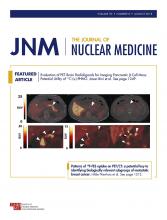Abstract
Heterogeneity of estrogen receptor (ER) expression in breast cancer is recognized. However, knowledge about varying expression across metastases and surrounding normal tissue in patients is scarce. We therefore analyzed 16α-18F-fluoro-17β-estradiol (18F-FES) PET to assess ER expression heterogeneity. Methods: 18F-FES PET on accredited PET/CT camera systems performed in patients with ER-positive metastatic breast cancer November 2009–December 2014 was analyzed. Lesions with an SUVmax 1.5 or more were considered ER-positive, but liver lesions were excluded given high background liver signal. CT lesions with a diameter 10 mm or more were included. We used multilevel linear-mixed models to evaluate determinants of 18F-FES uptake. Cluster analysis was performed with different imaging features per patient as input variables. Results: In 91 patients, 1,617 metastases in bone (78%), lymph node (15%), lung (4%), or liver (2%) were identified by CT (11.2%), PET (56.6%), or both (32.2%). Median tumor uptake varied greatly between patients (SUVmax, 0.54–14.21). 18F-FES uptake in bone metastases was higher than in lymph node and lung metastases (geometric mean SUVmax, 2.61 [95% confidence interval (CI), 2.31–2.94] vs. 2.29 [95% CI, 2.00–2.61; P < 0.001] vs. 2.23 [95% CI, 1.88–2.61; P = 0.021]), respectively. Cluster analysis identified 3 subgroups of patients characterized by particular metastatic sites and 18F-FES PET/CT features. SUVmax in surrounding normal tissue, highest in the bones, varied per patient (range, 0.7–3.3). Conclusion: 18F-FES uptake is heterogeneous in tumor and normal tissue and influenced by anatomic site. Different patterns can be distinguished, possibly identifying biologically relevant ER-positive metastatic breast cancer patient subgroups.
Footnotes
↵† Deceased.
Published online Mar. 30, 2018.
- © 2018 by the Society of Nuclear Medicine and Molecular Imaging.







